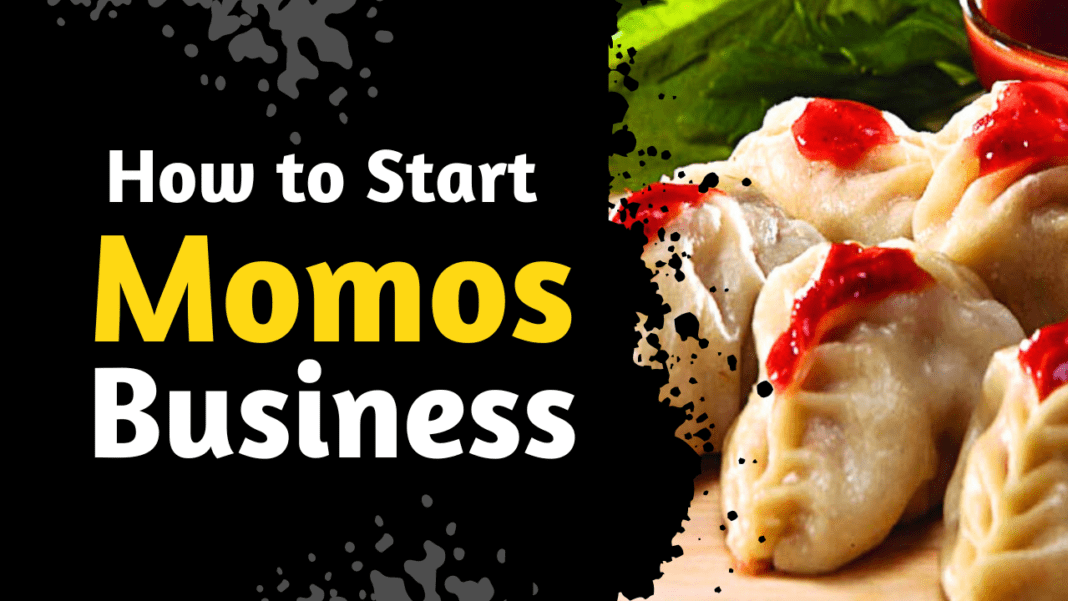Momos is a delicious Himalayan dumpling. They have earned a special place in the hearts of food lovers worldwide.
Originally from Tibet, these dumplings can be steamed or fried and are filled with a variety of ingredients, including vegetables, cheese, chicken, and pork. Due to their increasing popularity, starting a momos business can be a profitable and rewarding business.
What are momos?
Momos are a popular and savory dumpling dish originating from Tibet, but widely enjoyed across South Asia.
These delectable treats consist of steamed or fried dough envelopes filled with a variety of ingredients, often minced meat (such as chicken, pork, or lamb), vegetables, and aromatic spices. The dough is typically made from wheat flour and water, resulting in a soft and delicate texture.
Momos are commonly served with a spicy dipping sauce, adding an extra burst of flavor. Due to their delicious taste and adaptability, momos have become a beloved street food and a favorite dish in many restaurants, delighting food enthusiasts worldwide.
Why start a momos business?
Starting a momos business can be a innovative and rewarding experience for several reasons:
- Growing Popularity: Momos have gained huge popularity in recent years, both locally and internationally, as people have developed a taste for diverse and unknown cuisines.
- Unique Selling Proposition: Momos offer a unique and distinct flavor profile, making them stand out from other fast-food options, creating a niche market for your business.
- Flexibility in Menu: Momos can be filled with various ingredients, catering to a wide range of dietary preferences, including vegetarian, non-vegetarian, and even vegan options.
- Affordability: Momos are relatively inexpensive to make, allowing for attractive profit margins while keeping prices affordable for customers.
- Versatility: Apart from a dine-in or takeout restaurant, momos can be easily adapted for food trucks, catering events, and delivery services, increasing the potential customer base.
- Cultural Appeal: Introducing momos to regions where they are less common can spark curiosity and interest in diverse cultural cuisines.
- Low Initial Investment: Starting a momos business doesn’t require a minimum investment as compared to some other food ventures, making it accessible to aspiring entrepreneurs.
- Repeatability: Momos’ delightful taste and consistent quality can lead to repeat customers, fostering a loyal customer base.
- Business Expansion: A successful momos business can expand by opening multiple locations or franchise opportunities.
- Passion for Food: If you have a passion for food and cooking, running a momos business can be an enjoyable way to share your culinary creations with others.
Researching your target audience
Researching your target audience is important to understand their needs and behaviours. Here are some effective methods to conduct audience research for your momos business:
- Surveys and Questionnaires: Create online or in-person surveys to collect feedback from potential customers. Ask about their food preferences, favorite dishes, food habits and what they look for in momos.
- Social Media Listening: Monitor social media platforms to observe conversations, comments and reviews related to Momos.
- Competitor Analysis: Analyze the customer base of existing momos businesses and their social media presence.
- Focus Groups: Organize focus group sessions with various individuals to have in-depth discussions about momos, their expectations, and potential improvements.
- Local Demographic Data: Collect demographic information about the area where you plan to open your momos business. This includes age, income levels, cultural backgrounds, and eating habits.
- Feedback Forms: After customers visit your momos outlet, offer feedback forms to know their opinions about the food, service, and overall experience.
- Online Food Communities: Join food-related forums and communities to engage with food enthusiasts and learn about their preferences.
- Customer Interviews: Conduct one-on-one interviews with customers who have tried momos before to understand their experiences.
- Keyword Research: Use keyword research tools to identify popular search terms related to momos.
- Seasonal and Regional Trends: Consider seasonal and regional preferences for momos fillings and flavors to adapt your menu accordingly.
Demand for Momos in the Market
- Increasing awareness and interest in global cuisines
- The rising popularity of Asian street food
- Diverse flavor options (vegetarian, vegan, meat lovers)
- Social media influence
- Affordable and convenient fast food option
- Expansion of momo restaurants and food stalls in urban areas
- Integration of momos in fusion cuisine & innovative variations (e.g., cheese-filled momos, chocolate momos)
- Inclusion of momos in the menus of mainstream restaurants, cafes, and food trucks
- Positive word-of-mouth and recommendations from friends, family, and online communities.
Momos Business Statistics in India
1. In India, momos are widely consumed across various cities and towns, catering to a diverse customer base.
2. Momos business statistics in India indicate a successful industry. The market for momos has grown rapidly, with many momo stalls, restaurants and food chains emerging in both urban and rural areas.
3. This growth can be attributed to several factors, including the affordability, convenience, and unique taste of momos.
4. The business provides employment opportunities to a significant number of individuals, including street vendors, restaurant staff, and food delivery personnel.
5. Furthermore, with the advent of technology and online food delivery platforms, momos have become more accessible to consumers, leading to increased sales and revenue.
Overall, the momos business in India has experienced remarkable growth and shows promising prospects for the future, driven by the rising demand and evolving culinary preferences of the Indian population.
Find Targetted Audience
- Food lovers and adventurous eaters
- Young professionals and students
- Urban residents with busy lifestyles
- Vegetarians and vegans looking for plant-based momos options
- Ethnic food lovers interested in exploring Asian cuisine
- Social media-savvy individuals who enjoy sharing food experiences
- Individuals seeking convenient and quick snack options
- Families and parents looking for tasty and nutritious food for their children
- Tourists and travelers interested in trying local street food
Remember, it’s important to conduct thorough market research and tailor your marketing strategies based on your specific location and customer preferences.
Planning and Preparation
Developing a business plan
Developing a business plan is an essential step in starting and growing a successful business. It serves as a roadmap for your business, outlining your goals, strategies, and financial projections. Here’s a step-by-step guide to help you create an effective business plan:
- Executive Summary: This section provides a brief overview of your business idea, including the mission and vision, products or services offered, target market, and key differentiators. Keep it concise but compelling to capture the reader’s interest.
- Company Description: Describe your company in more detail, including its legal structure, location, founding team, and the problem your business aims to solve. Explain why your solution is unique and how it addresses market needs.
- Market Analysis: Conduct thorough research on your industry, target market, and competitors. Identify your target customers, their preferences, and buying behaviour. Analyze your competitors’ strengths and weaknesses to understand how you can position your business effectively.
- Organization and Management: Outline your organizational structure and key team members’ roles and responsibilities. If you’re a solo entrepreneur, describe your expertise and how you plan to manage the business.
- Products or Services: Provide comprehensive information about the products or services you’ll offer. Explain their features, benefits, and any intellectual property you may have.
- Marketing and Sales Strategy: Detail your marketing and sales approach to reach your target audience. This should include your pricing strategy, promotional activities, distribution channels, and sales tactics.
- Funding Request (if applicable): If you’re seeking funding, specify the amount you need and how you’ll use it. Include a detailed breakdown of how the funds will be allocated.
Choose The Appropriate Location
- High Foot traffic
- Good Visibility
- Proximity to target market
- Competition: ensure there is a balance to attract customers without overwhelming competition.
- Parking and accessibility
- Conduct market research
Space :- 100 to 600 Square Feet
Obtaining necessary permits and licenses
The most important license that an entrepreneur needs to start a Pizza business is
- FSSAI License
- GST
- TAN no.
- Trademark
- Company may need to be registered.
Setting Up your Momos Business
Designing your momos menu
Designing a momos menu requires a balance of traditional favourites and creative variations to cater to a wide range of tastes. Here’s a sample momos menu that includes various options:
1. Classic Momos:
- Chicken Momos: Minced chicken with onions, garlic, and ginger, wrapped in a thin dough and steamed. Served with traditional momo sauce.
- Vegetable Momos: A delightful mix of fresh vegetables, tofu, and aromatic spices enclosed in a delicate wrapper. Served with momo sauce.
2. Special Momos:
- Paneer and Spinach Momos: Soft paneer (Indian cottage cheese) blended with spinach and herbs, wrapped in a thin layer of dough. Served with mint-coriander chutney.
3. Steamed or Fried:
- Steamed Chicken and Shrimp Momos: A delightful combination of chicken and shrimp with a medley of herbs and spices, steamed to perfection.
- Fried Veggie Dumplings: Crispy and golden-fried vegetable momos served with a side of spicy tomato-garlic sauce.
4. Dessert Momos:
- Chocolate and Banana Momos: Sweet dumplings filled with Nutella and sliced bananas, dusted with powdered sugar and served with a drizzle of chocolate sauce.
- Caramel Apple Momos: Caramelized apple slices spiced with cinnamon, wrapped in momo dough, and served with a scoop of vanilla ice cream.
5. Sides and Dips:
- Momo Sauce: A classic momo sauce made with tomatoes, red chillies, garlic, and a hint of soy sauce for an extra kick.
- Mint-Coriander Chutney: A refreshing blend of fresh mint, coriander, green chillies, and lemon juice to complement the momos.
- Spicy Tomato-Garlic Sauce: A zesty tomato sauce with garlic, red pepper flakes, and a touch of honey for sweetness.
Remember to consider dietary preferences and offer vegetarian and vegan options. Additionally, you can create combo meals that include a variety of momo flavours along with sides and drinks. An inviting and visually appealing menu design can also enhance the overall dining experience.
Hiring and training staff
- Chef/Cook
- Kitchen Staff
- Servers
- Cashiers
- Cleaning Staff
- Manager/Supervisor
Raw Material & Machinery for Momos Business
To start a momos business, you will need raw materials and machinery to produce and serve the momos. Here are some essential items you will need:
Raw Materials
- Flour
- Meat or Vegetables:- Need ingredients like minced meat (such as chicken, pork, or lamb) or vegetables (such as cabbage, carrots, and onions).
- Seasonings and Spices
- Wrappers
Machinery and Equipment
- Mixing and Dough Preparation
- Filling Preparation: Knives, cutting boards, and food processors
- Steamer
- Cooking Utensils
- Refrigeration
- Storage
- Kitchen Appliances
Marketing and Promotion
Creating a brand identity
Creating a brand identity is a crucial process for any business or organization. It involves developing a unique and cohesive set of elements that convey your brand’s personality, values, and purpose.
Here’s a step-by-step guide to help you create a strong brand identity:
- Define your brand strategy: Before designing any visual elements, clearly define your brand’s mission, vision, values, target audience, and unique selling proposition (USP).
- Research your target audience: Conduct market research to understand your target audience’s preferences, needs, and pain points.
- Develop your brand personality: This personality will influence all aspects of your brand, from visuals to messaging.
- Design a memorable logo: Your logo is the visual representation of your brand and should be simple, unique, and easily recognizable.
- Choose a colour palette: Colors have a powerful impact on how people perceive and remember your brand. Select a colour palette that aligns with your brand personality and creates a consistent and harmonious visual experience across all platforms.
- Create a typography system: Choose fonts that complement your brand personality and are easy to read. Establish primary and secondary fonts to use consistently in your marketing materials.
- Design supporting visual elements: Develop a set of visual elements, such as patterns, icons, and graphics, that reinforce your brand identity and can be used across various marketing materials.
Remember that creating a brand identity is not a one-time task. It requires ongoing management and care to maintain consistency and relevance as your business develops.
Creating an online presence
Creating a strong online presence is crucial for businesses in the digital age. It allows you to reach a broader audience, build brand awareness, engage with customers, and drive business growth.
- Set Clear Goals: Define your objectives for being online. Are you looking to increase sales, build brand awareness, provide customer support, or all of the above?
- Build a Professional Website: Your website is the foundation of your online presence. Ensure it is visually appealing, user-friendly, and mobile-responsive. Include essential information about your business, products/services, contact details, and a clear call-to-action.
- Optimize for Search Engines (SEO): Implement SEO strategies to improve your website’s visibility in search engine results. Research relevant keywords, create valuable content, optimize meta tags, and build high-quality backlinks to improve your search rankings.
- Create Valuable Content: Content marketing is a powerful tool to attract and engage your target audience. Create blog posts, articles, videos, infographics, or other forms of content that provide value to your customers and showcase your expertise.
- Engage on Social Media: Choose social media platforms that align with your target audience and business goals. Regularly post relevant content, interact with your followers, and use social media advertising to reach a broader audience.
- Email Marketing: Build an email list and use email marketing to nurture relationships with your customers. Send personalized and relevant content, promotions, and updates to keep them engaged and informed.
- Online Advertising: Consider investing in online advertising, such as Google Ads or social media ads, to increase your visibility and drive traffic to your website.
- Local Business Listings: Claim and optimize your business listings on Google My Business and other local directories. This will help local customers find and connect with your business.
- Monitor Online Reviews: Pay attention to online reviews and respond promptly and professionally. Positive reviews can boost your reputation, while addressing negative feedback shows that you care about customer satisfaction.
- Measure Results: Use web analytics tools to track the performance of your online efforts. Monitor website traffic, social media engagement, conversion rates, and other relevant metrics to evaluate the success of your online presence.
- Stay Consistent: Consistency is key to maintaining a strong online presence. Regularly update your website and social media channels with fresh content and ensure your messaging aligns with your brand identity.
- Adapt and Evolve: The online landscape is constantly changing. Stay informed about industry trends and adapt your online strategy accordingly to stay ahead of the competition.
Remember that building an online presence takes time and effort. Be patient and persistent, and focus on delivering value to your audience to establish a lasting and impactful presence online.









